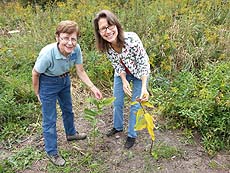Fermilab and Eco Rangers safeguard the monarch butterfly
 |
| Fermilab docent Dee Huie, left, and Education Office's Maureen Hix show off the milkweed plants intended to attract monarch butterflies to the Fermilab site. The greener milkweed on the left was grown from seed and does not yet have a seed pod. The more yellow milkweed, which has a seed pod, was transplanted to the site. Photo: Rich Blaustein |
The monarch butterfly has been in the news recently because of its dramatically dwindling population due to a variety of factors, including habitat loss and increased herbicide use. In fact, in the February 2014 Canada-Mexico-USA summit, the nations' leaders directed the formation of a working group on protecting the monarch butterfly, which journeys between the three countries and famously winters in a narrow band of central Mexican mountain forest.
Fermilab is doing its part to protect the monarch butterfly, the official Illinois state insect that graces the state during all its life stages, including adulthood, when the butterflies sport their beautiful orange wingspan of up to 5 inches. This spring, Fermilab's Eco Rangers, middle and high school student stewards who learn about nature and restore prairie habitat on the Fermilab grounds, started clearing a 16-foot-by-16-foot
"monarch waystation" near the Lederman Science Center. They are currently planting the site with native milkweed, which provides critical food and habitat for the monarch from its egg through caterpillar stage. The Eco Rangers will continue seeding the waystation plot with milkweed and will add a variety of nectar plants, which are the adult monarch's food source.
"The purpose of a waystation is to give monarch butterflies a safe place to get nectar and a safe place to lay their eggs along the migration path," explained Maureen Hix of the Lederman Science Education Center. Hix developed and leads the Eco Rangers program.
The University of Kansas-based MonarchWatch center oversees a national effort for monarch waystations and certifies that they meet specific standards, such as for the mixture of milkweed and nectar plantings.
The Eco Rangers must meet both MonarchWatch and Fermilab guidelines, which require that the introduced plant species are indigenous to this area.
Head of Roads and Grounds Dave Shemanske and his team have assisted with getting good milkweed plants and seed from the grounds, Hix said, and Ryan Campbell, chief ecologist at Fermilab, has been advising her and the Eco Rangers on how to start and maintain a waystation.
"There's a lot of support from Roads and Grounds. It's important getting the expertise of Fermilab people behind you," Hix said. "And then the Eco Rangers do the work of digging, weeding and reseeding."
Lederman Center docent Dee Huie agrees with Hix that the Eco Rangers are doing a great job and that monarch waystations are important for conservation. She is especially gratified because of her passion for insects.
"Bringing back the insects that were once here is very important for the restoration of the prairie ecosystem," Huie said.
Hix is proud of what the Eco Rangers are doing for the monarch butterfly.
"It is going to take a while, but I have some very dedicated Eco Rangers," Hix said.
"And, actually," Huie added, "they have a very good leader in Maureen."
—Rich Blaustein
|